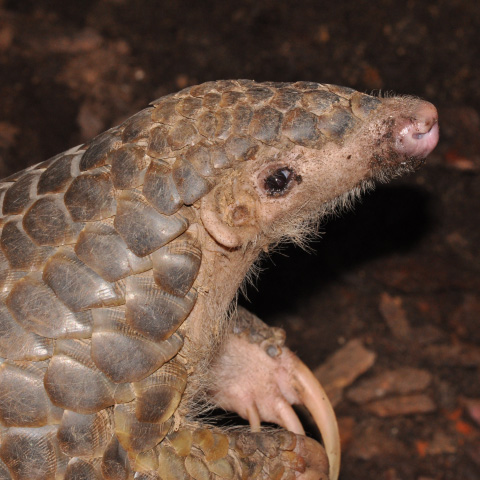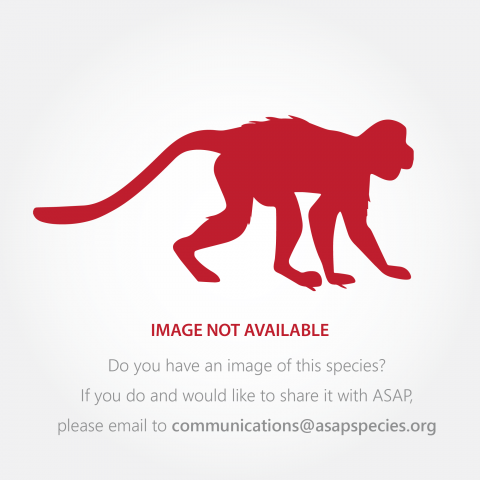Conservation Actions
This species is listed on CITES Appendix I, it is protected by the Indonesian law, and it belongs to the world’s 25 most endangered primates (Paciulli et al. 2015). It currently occurs in only one officially protected area (Siberut National Park), and is never seen in captivity (M. Richardson pers. comm). Whittaker (2006) suggests the following conservation actions: "1) increased protection for Siberut National Park, which currently lacks enforcement, 2) formal protection of the Peleonan forest in North Siberut, which is home to unusually high primate populations and is easily accessible, 3) protection of areas in the Pagai Islands by cooperating with a logging corporation that has practiced sustainable logging technique there since 1971, 4) conservation education, especially regarding hunting, and 5) the development of alternative economic models for the local people to reduce the likelihood of selling off their lands to logging companies."
Quinten et al. (2014) further suggest (i) lobbying the local government to ban the use and possession of air rifles throughout the archipelago, and confiscate such weapons; (ii) an island-wide campaign to emphasize cultural tradition in order to increase the hunters’ inclination to follow traditional practices and taboos, including ceremonial rather than opportunistic hunting; (iii) improving agricultural practices to decrease dependence on primates for animal protein; (iv) active inclusion of locals into conservation projects and environmental tourism ventures on Siberut as guides and field assistants who can act as multipliers for a positive conservation message in their communities.
Location Information
This species is endemic to Indonesia. It is confined to the Mentawai Islands off the western coast of Sumatra and a few local offshore islets.
- Simias concolor concolor occurs in the Mentawai Archipelago (on the three southern islands, South Pagai, North Pagai, Sipora, and the nearby islets of Simalegu and Sinakak).
- Simias concolor siberu occurs in the Mentawai Archipelago (on the northernmost island, Siberut).
Geographic Range
Extant
Indonesia
Population Information
In 2006, the population estimate for the species as a whole was 6,700–17,300 individuals, down from an estimated population of 26,000 in 1980 (Whittaker 2006). This represents a decline of 33–75% over 26 years (1980-2006). Over the last 10 years it is estimated to have undergone a further decline; it is therefore estimated that the population has declined by over 80% in 36 years (three generations).
Simias concolor concolor
The most recent surveys of this species estimated densities of five individuals/km² in unlogged forest, and 2.5 individuals in forest patches logged 20 years ago (Paciulli 2004). Its mean population density was estimated at 21 individuals/km² in 1994 (Tenaza and Fuentes 1995). This would indicate a decline of 73 to 90% in 10 years (Whittaker 2006). Most likely, the species has been driven to extinction on two of the islets at the South of South Pagai Island (Yanuar et al. 1998). With its total population estimated to number only 700-1,800 individuals (Whittaker 2006), S. c. concolor is urgently in need of protective measures.
Simias concolor siberu
For the Siberut subspecies, more recent studies are available, estimating this primate to live in relatively undisturbed lowland rainforest on mineral soil at densities of ca. 53.1 individuals/km² (range: 38.8–72.5), representing values comparable to adjacent peat swamp forest (Peleonan Forest, North Siberut; Waltert et al. 2008 and Quinten et al. 2010). For Siberut National Park, which covers >40 % of the island’s western side, surveys in 2011/12 yielded substantially lower density estimates: 8.5 (5.0-14.5) individuals/km²; on this basis, it was estimated that ca 14,112 (8,252-24,133) Pig-tailed Langurs still inhabit the park (Quinten et al. 2015). Previously, the total population on Siberut was estimated to comprise between 6,000-15,500 individuals (Whittaker 2006), however, the more recent estimates of Quinten et al. (2015) suggest these numbers for Siberut National Park alone.
Threats
This species is threatened mainly by heavy hunting and commercial logging (Whittaker 2006, Quinten et al. 2014). It is also threatened by the conversion of rainforest into oil palm plantations, as well as forest clearing and product extraction by local people. Sometimes, animals are taken for the pet trade (Whittaker 2006).
Over the last two to three decades, hunting pressure has increased because of improved access to remote areas due to logging roads and tracks, as well as the replacement of bows and arrows with air rifles (Whittaker 2006). Also, local rituals and taboos that formerly regulated hunting have been progressively eroded due to missionary and state influences (Whittaker 2006; Quinten et al. 2014). S. concolor is the preferred game species of most Mentawai hunters (Mitchell and Tilson 1986, Fuentes 2002, Paciulli 2004, Quinten et al. 2014). Tenaza (1989) estimated that twice as many individuals are killed by hunters each year as are born in the Pagai Islands. On Siberut Island, interview surveys in 50 villages revealed that 24% of the respondents were ‘active hunters’ and 77% of those respondents target Simias concolor. The average number hunted per three months was 1.9 and a minimum off-take of over 1,600 individuals per year (>10 % of the total population) was estimated (Quinten et al. 2014). Hunting also appears to reduce group size, and to significantly affect adult sex ratios as well as the number of immatures in groups (Erb et al. 2012b). Consumption as well as cultural/ceremonial reasons were most often given as a justification for hunting the species (Quinten et al. 2014).
At present, the Pig-tailed Snub-nosed Langur is listed on the IUCN Red List (Ver 3.1) as “Critically Endangered” on the basis of criteria A2cd; this equally applies to its two subspecies, S. c. concolor and S.c. siberu. It means that the species along with its subspecies was assessed to be at an “extremely high risk of extinction” due to “(A) An observed, estimated, inferred or suspected population reduction (2) of ≥80% over the last 10 years or three generations […] based on (c) a decline in area of occupancy, extent of occurrence and/or quality of habitat and (d) actual or potential levels of exploitation” (see Whittaker 2006). From its first evaluation up until the previous one in 2008, Simias concolor was listed as “Endangered” (IUCN 2008). Whittaker (2006) explicitly details the reasons for the upgrade to Critically Endangered in her Conservation Action Plan for the Mentawai Primates:
“The most recent survey of Simias density was conducted in the Pagai Islands, where densities ranged from 5 individuals/km² in unlogged forest to 2.5 individuals/km² in forest patches logged 20 years ago (Paciulli 2004). If about 2,700 km² of primate habitat remains in the Mentawai Islands, then there are 6,700–7,300 simakobu monkeys today, representing a decline of 33 –75% from the 1980 estimate of 19,000 simakobu monkeys in Siberut (26,000 in all four Mentawai Islands). The loss may have been even greater than this estimate: more recently, the mean population density for Simias throughout the Mentawais, based on home range sizes, was estimated as 21 individuals/km² (Tenaza and Fuentes 1995). Based on this density and a very conservative estimate of 3,000 km² of forest, there were 63,000 simakobus in 1994, indicating a possible loss of 73–90% of the population in 10 years. The loss is likely greater in the Pagai Islands, where logging has been more of a problem and hunting has been facilitated by logging roads, than in Siberut. The primary threat to Simias is hunting, as it is the preferred game of most Mentawai hunters (Mitchell and Tilson 1986, Fuentes 2002, Paciulli 2004). In 1990, Tenaza and Fuentes (1995) found no simakobu monkeys in a site in Siberut that had an unusually high density (~220 individuals/km²) when surveyed by Watanabe (1981) in 1974–1978. The site had been logged, and after logging had ceased, local people reported that hunting the simakobus was easier because there were fewer places for them to hide (Tenaza and Fuentes 1995). This evidence of heavy hunting suggests the higher estimate of decline may be more correct.”
The situation for this primate, as described above by Whittaker, remains virtually unchanged until today, with hunting and habitat loss still being the main threats: Previous estimates put the entire Siberut subspecies at 6,000-15,500 individuals (Whittaker 2006), although more recent data suggest that ca. 14,112 individuals (range: 8,252-24,133) live within Siberut National Park alone, an area covering over 40 % of the northern island. At the same time, much of the area outside the park is designated production forest and agricultural area, so – with few exceptions (e.g. Peleonan Forest in N-Siberut) – it is questionable whether this species still survives in high densities outside the park. Furthermore, the hunting threat has recently been quantified for the first time, painting a somewhat bleak picture: An average annual off-take of between 1,600 and 3,200 individuals was estimated (Quinten et al 2014), which - based on Whittaker’s estimates - would mean anything between 10 and 50 % of the population. While no recent data are available from the three southern islands, the old estimates of only 700-1,800 individuals (Whittaker 2006) are quite low, illustrating that S. s. concolor is urgently in need of protective measures.
On this basis, it is recommend that the status of S. concolor should be maintained as Critically Endangered, and this should apply equally to both subspecies.
IUCN Red List Account Link
Please click here to see the species' IUCN Red List Account page.Photo Credits
Kasih Putri (category and featured image)




